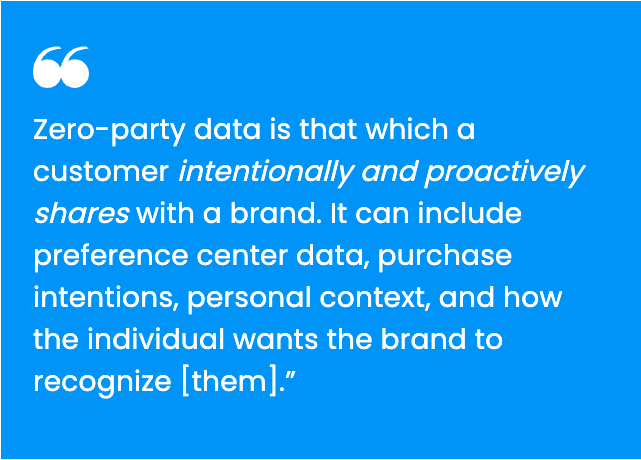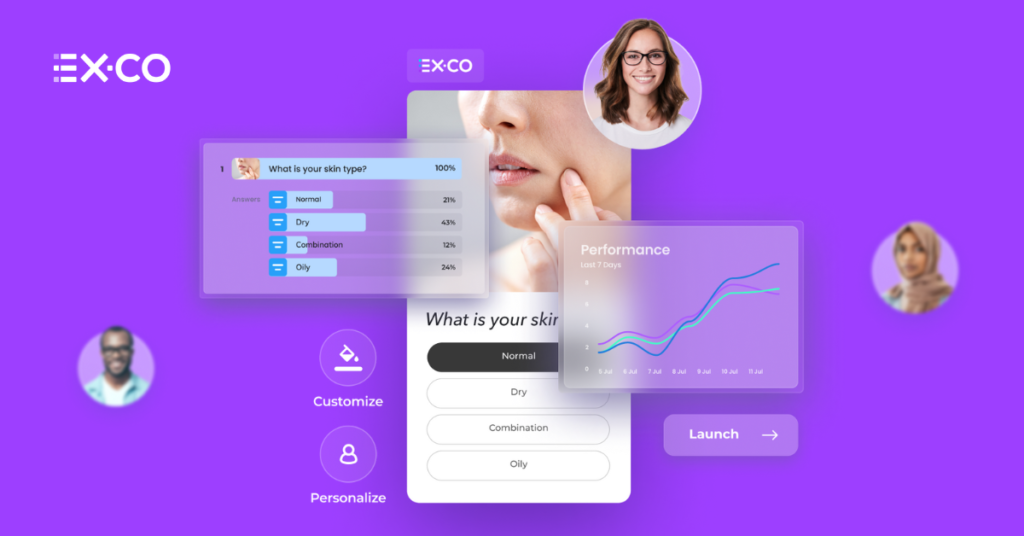Do you have a corner market that you go to every day? Does the owner of that market know, because you’ve been going there for weeks/months/years, that your dog’s name is Hobo, that your favorite color is green, that you want to buy a candy bar but are on a diet and that you are going to buy a newspaper and a cup of coffee every Monday through Friday, so it’s always ready and waiting for you?
If that sounds familiar, then let’s translate that personalized corner market experience to the world of e-commerce. There’s a way to personalize the online shopping experience too, and It’s not as difficult as you might think. It simply requires getting to know your customer more. How? By gathering zero-party data.
Seriously. The industry is abuzz with this type of data. In case you’re wondering, the term “zero-party data” isn’t that new, but you better believe it’s crucial to the immediate future (and beyond) of data collection.
What is Zero-Party Data?
Since Forrester coined the term circa 2017, let’s start with their definition:

What’s most important in that definition? You got it: intentional and proactive. This is the information that a customer willingly provides you when asked. This is the information that you could discover if you were in a brick-and-mortar store just chit-chatting with a customer, learning about them as an individual person.
Zero-Party Data vs. First-Party Data
You already receive personal, individual information, specifically provided by your customers when they make a purchase from our website. It’s called first-party data and includes:
This information isn’t given intentionally and proactively. It’s either a requirement to receive the product they’ve purchased or information that your site collects within the standard process of e-commerce transactions.
With zero-party data, we’re talking about something else altogether.
Let’s return for a moment to our corner market scenario. One of the best ways to keep customers happy and coming back for more is to get to know them personally and anticipate their needs, which is precisely what zero-party data can provide. It’s not merely data; it’s a bridge to building a relationship which makes the customer feel seen and valued, as well as providing the best personalized products for their specific needs.
Why is Zero-Party Data So Important?
Increasingly, there are two very important Ps to the consumer: privacy and personalization. At first glance, these two Ps present a paradox, but thankfully, there’s a way to address this paradox: with zero-party data.
(1) Privacy
Privacy is a hot-button topic in our global society. Industry regulations like GDPR and CCPA have put safeguarding consumer privacy at the forefront. (Here’s a great matrix by WireWheel that compares global consumer privacy laws). Those recent regulations have given consumers the ability to opt out of third-party cookies. This means the flow of that data is turning from a stream into a trickle for your e-commerce business.
Before you get frustrated about these new regulations, remember that creative minds can always find solutions to overcome perceived obstacles. Often those solutions turn out to be better for your business and brand than you ever could have imagined. You are forced to think about how to reach and retain your customers in more positive and proactive ways.
Before you get frustrated about these new regulations, remember that creative minds can always find solutions to overcome perceived obstacles. Often those solutions turn out to be better for your business and brand than you ever could have imagined. You are forced to think about how to reach and retain your customers in more positive and proactive ways.
(2) Personalization
And zero-party data is one of those ways. Since zero-party data requires consumer consent, it is automatically compliant with all privacy regulations. Plus, it will give you an opportunity to create a more personalized customer experience. Customers want to feel like you know them and perhaps even more importantly, they will notice when you don’t. Just like in the corner market scenario, customers will share their personal information with you if you ask them directly while they are already interacting with your brand.
This personal exchange of information ultimately provides you with better data so you can eliminate any guesswork. It’s better data because it:
How Can E-Commerce Companies Collect Zero-Party Data?
Believe it or not, collecting zero-party data is relatively easy. If you’ve been working toward making a more personalized experience for your customers, say to improve average order value or customer retention, then you already have the ability to collect zero-party data. Here are just a few additional zero-party data collection options:
-
Newsletter/subscription registrations
-
Make subscribing to your newsletter part of the customer experience when they first visit your site
-
Personalize your newsletter with actions built in – like quizzes or surveys – so the customer will be more likely to engage and not simply toss it in their spam folder
-
-
Social media
-
Collect large sets of data about current and future trends and demographics through polls and surveys
-
-
Interactive experiences, like quizzes, micro-experiences, or customer journeys that:
-
Encourage website visitors to make choices, share what they like, and reveal their interests as well as who they are as people
-
Leverage the data you collect to provide more personalized recommendations of products
-
How Do You Use the Data Once You Have It?
That’s the big question, isn’t it? You’ve done all this work to collect zero-party data but now what? Hint: it’s all about personalization.
Since privacy regulations are becoming more challenging to comply with, zero-party data is definitely the most efficient way to get the data you need in a privacy-compliant way. With this newfound data, you are now primed to personalize your entire e-commerce digital footprint so visitors will see what they want when they want it. Having zero-party data will empower you to create:
Let’s not forget that once you’ve collected zero-party data, you need to show the customer that you’ve listened. Use this valuable information to improve the shopping experience for them. The customer gives, you give back.
What are the Benefits of Having Zero-Party Data?
How much time do you have? The benefits to your brand are innumerable and mutual for your customers. Since there’s not enough time to list them all, let’s list just a few key benefits:
I’m guessing by now you’re realizing that zero-party data is the future of e-commerce for a reason. The true beauty of zero-party data is that the benefits are ultimately mutual for both your business and your customers.
Remember our corner market scenario? Let’s say what hasn’t been said yet. The reason you keep going back to that corner market isn’t simply because it’s on the corner of your street or that it carries exactly what you need. Afterall, there are other corner markets. You return to that specific store because the owner took the time to find out who you were, which is priceless.
Ready to experience how collecting zero-party data with EX.CO can boost your business? Drop your details below.
